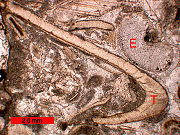
Bioclast
Encyclopedia

Geologist
A geologist is a scientist who studies the solid and liquid matter that constitutes the Earth as well as the processes and history that has shaped it. Geologists usually engage in studying geology. Geologists, studying more of an applied science than a theoretical one, must approach Geology using...
s, archaeologists and paleontologists use to date a rock strata to a particular geological era.
Bioclasts used for such relative dating purposes can be whole fossils or broken fragments of organisms. Their preponderance can give a rough guide to life diversity in the historic biosphere, but absolute counts much depend on water conditions such as the depth of the deposition, local currents, as well as wave strength in large body of water such as lake.

